As a kid, I played a lot of video games that simulated warfare. I’m not sure why, but I always enjoyed setting up scenarios and the units on both sides of the map, just to see how it would turn out in the end. It’s either that, or I’ve watched Matthew Broderick break into WOPR (no, not the sandwich…watch your WarGames, kids) one too many times.
Boom & Zoom is not only a game that simulates warfare, but it gives players the tools they need to customize their experience however they wish. The manual itself has ten scenarios (called missions), rules and all, for players to try out. As such, there is not a clear-cut game-wide objective, as they change based on the mission that you are currently playing. For review purposes, I’ll be covering the rules and gameplay found in the first (and easiest) mission. Most of the missions that follow are variants of the first mission…that is…introducing new rules that tweak overall gameplay.
Before we get started, I wanted to thank Stephanie Marroquin from Victory Point Games for sending me a free review copy. She was very polite and helpful in answering all of my questions.
Components
Towers / Counters – The main game pieces (made of thick cardboard) come in either red or blue and represent the towers that players will be moving around the board. They come in various shapes with different numbers printed on them, indicating their movement and attack range. Towers are built with the smallest number on the bottom, working their way up.
Map – The map that comes with the game is two sided…one represents a small map (8×8 grid) and the other represents a full map (10×16 grid). You’ll be using either or, depending on which mission you end up playing.
Terrain Tiles – These square tiles are placed on certain spaces of the playing field before the match begins and change the way pieces move about and attack. They won’t make an appearance in all missions, however.
Setup & Gameplay
As I mentioned above, each mission is set up a little differently and the rules in some are more complex than others. Below is an overview of the “Commanding Towers” scenario, or “Mission One.” It will still give you an idea of how the other scenarios play, despite their variants.
Setting up the first mission is very simple. Each side gets eight towers, three high (called three-point towers), and are placed on the row closest to each player. No terrain tiles are used. The youngest player goes first.
On a player’s turn, they may do ONE of the following:
1) Boom – Attack an enemy tower with one of their own:
Towers can only attack in straight lines, though they can attack diagonally. Its range is dependent on the value of the tower…for example, a two-point tower can attack up to two spaces away. A tower cannot shoot through other towers, even if they are friendly. A successful attack reduces the enemy tower by one point and is destroyed if the tower was “1” to begin with.
2) Zoom – Move one of their own towers:
Towers can only move in a straight line, though they can move diagonally. They cannot jump over other towers nor occupy the same space as another tower (stacking). Its range is dependent on the value of the tower…for example, a three-point tower can move up to three spaces.
Editor’s Note: The pieces move and attack much in the same manner as the queen in Chess. Think of every tower as being a queen, except that its movement (in terms of number of spaces) is restricted and constantly subject to change.
Scoring and Endgame
The objective of this mission is to move your towers off of the board on your opponent’s side. Think of a checker piece reaching the last row, but instead of being “kinged”, must spend one more movement point to go off of the board. Each tower piece that manages to exit the board in this fashion scores a point and is kept in a separate score pile so that players can tally them at game’s end. The numbers on the tower pieces are ignored and each tower piece serves as one point. If a three-point tower makes it off of the board on their opponent’s side, for example, they’d score three points. Scored towers are lost forever and cannot come back.
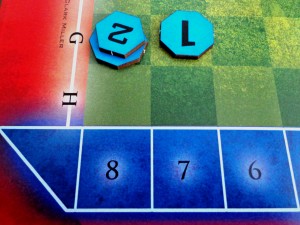
Blue’s two-point tower can go off the board and score, however the one-point tower only has enough movement points to make it to the last row and will need to be moved again to score.
The game ends when one side has no more towers / pieces to move. At that point, each score pile is totaled and the person with the most points wins.
Please keep in mind that the above is simply an overview of the first mission. You can get more details and check out the many variants this game has to offer by viewing the manual, located here:
The Review
What drew me into this game right away was the play mechanics. This game uses ideas and gameplay mechanics from games like Chess, Checkers, and Khet but stays flexible enough so that players can customize their game however they want. The ten missions listed in the manual are simply suggestions to help players get going…but honestly, players are only limited by their imagination.
Since there are many missions that offer varying degrees of complexity, I am able to play the game with just about anyone. If I feel that one of the missions may be too much for one of the kids, I can pick or design one that is easier to play. It’s refreshing to find a game that works around your learning curve, rather than it being the other way around.
In terms of strategy, this game has a lot going for it. Initially, players will be trying to manuever their towers in such a way as to knock out the enemy towers as efficiently as possible…that is…without suffering losses themselves. All of that changes towards the end of the game when players begin to have more space and realize that they need to start scoring some of their towers. However, scoring towers too early might leave you defenseless to stop your opponent from waltzing all over the rest of your forces. On the other hand, if you can score a bunch of towers and force the game’s end, your opponent will not earn credit for the towers still in play and more than likely lose.
Vinnie (11) quickly jumped into the first mission after a quick rules primer. Even though the moves and gameplay are relatively simple in the first mission, I could tell he was really thinking about how best to position his towers. He is fairly good at the game of Chess, so his familiarity with the queen piece helped him understand how the towers moved and attacked. He’s still learning how to think ahead and envision the consequences that come with certain actions, but he surprised me quite a few times with some excellent moves that even I hadn’t considered. He played very aggressively, forcing me to keep my towers together so as not to lose a one on one shooting match.
Their cousin Devonn (11) joined in on the fun, trying to best me as well in the first mission. It was interesting to see how different his play style was in regards to Vinnie’s, seeing as how they are the same age. I was forced to adapt in a different manner as he played a more balanced game. Our roles in regards to offense and defense constantly changed and we pecked each other’s towers to death slowly but surely.
We all agreed to try our luck with the next few missions listed in the rule book and equally had a good time with them. I enjoyed the variations that each mission brought to the table, as it changed the way we played in the first mission. Strategies that worked for someone in the first mission no longer proved to be a good idea in later ones.
There is one major issue that prevents me from giving this game a perfect ten, and that is the quality of the components. The game itself came without a box and instead was in a large baggie. I was willing to look past that, but as I was punching out the cardboard tower pieces, I noticed that my hands had changed color. My fingers were blackened and it appeared to be coming from the sides of the tower pieces. Some of the tower pieces appeared stained / discolored as well, and one of the stickers fell off its piece. The mat itself is colorful, but again, very basic in terms of quality. I don’t mind sub-par components if they still function well, but the kids and I should not have to wash our hands after we are done playing a board game unless markers are involved. The tower pieces were also a bit small…the four and five tower pieces being particularly difficult to grasp.

Maybe the problem is fixable with the proper know-how…but the point is, I shouldn’t have to fix anything.
The component bit was really disappointing as everything else about the game was fun. The flexible nature of the missions allow for high replayability, especially for those who are naturally creative. The game encourages critical thinking and forces players to think ahead…always a good skill to hone, especially in a young mind.
If the game were redesigned with better components (plastic/wooden tower pieces, a higher quality mat or board, a box rather than a baggie, etc.) I’d recommend it in a heartbeat. I realize that with a $20-$30 price tag that the components may suffer, but I’d honestly drop the extra few bucks to buy a better version…though that is just my opinion. Everyone is different and has varying expectations, but I can understand and sympathize if some paying customers felt upset over what they received.
If the component quality of a game in general doesn’t bother you, then I’d say give Boom & Zoom a try. Components aside, I had a lot of fun playing the game with the kids and foresee us playing the game again in the future.
Final Verdict: 7/10
You can find more information on Boom & Zoom by visiting the Victory Point Games website or on Board Game Geek, located here:

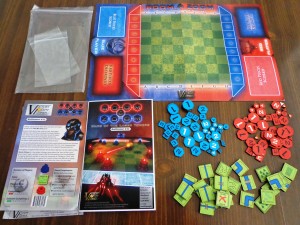
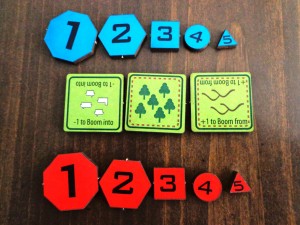
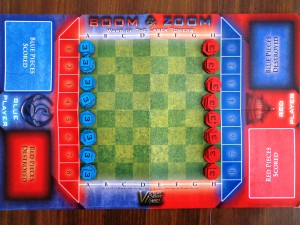
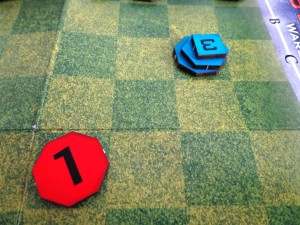
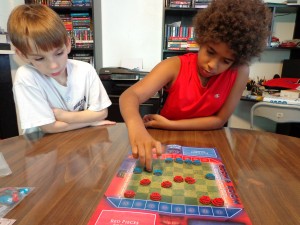
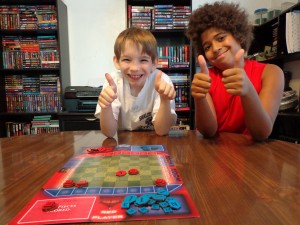
“If the game were redesigned with better components (plastic/wooden tower pieces, a higher quality mat or board, a box rather than a baggie, etc.) I’d recommend it in a heartbeat.”
Well, we’re laser-cutting the pieces a bit better now, have put the game in a box and included a mounted game board… So, you’ve pretty much got your wish now! 🙂
http://victorypointgames.com/details.php?prodId=213
Alan Emrich
Thanks for the update!